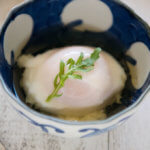
Onsen Tamago is a traditional soft-boiled egg that has runny egg white on the outside and almost hard egg yolk inside. Yes, it is the other way around to a standard soft-boiled egg where the egg white is hard and the yolk is runny. Eat Onsen Tamago in the traditional way with a special dashi-based sauce.
Prep Time includes the time to chill water in the fridge as well as taking the eggs from the fridge to room temperature.
It takes a long time to make Onsen Tamago but you are really not doing anything for most of the 2.5 hours!
Don't forget to see the section 'MEAL IDEAS' below the recipe card! It gives you a list of dishes that I have already posted and this recipe that can make up a complete meal. I hope it is of help to you.
- 4 eggs at room temperature (note 1)
- 1000ml/4 cups water
- 250ml/1cup water chilled to 4°C/40F° (note 2)
- 100ml/3.4oz dashi stock
- ½ tbsp cooking sake
- ½ tbsp mirin
- 1 tsp light soy sauce
- A pinch of salt (note 3)
- 4 tiny mizuna leaves or any other green leaves
-
Put all the Sauce ingredients in a saucepan and bring it to a boil.
-
Turn the heat off and cool the sauce down to room temperature.
-
Put 1000ml/4 cups water in a thick pot and bring it to a boil. Remove the pot from the heat.
-
Add the 250ml/1 cup chilled water to the pot.
-
Using a ladle, gently place each egg in the pot.
-
Place a lid on and leave for 25-30 minutes (note 5).
-
Transfer the eggs to a large bowl containing cold water to cool them down quickly and stop further cooking.
-
Crack open the egg, in the same way as cracking a fresh egg, into a small serving bowl. The egg should slide into the bowl easily because the egg white is runny.
-
Gently pour two tablespoons of the Sauce around the egg white and place a leaf on top if using. Serve with a spoon.
1. The time required to cook Onsen Tamago varies depending on the size of the egg as well. I used 2 x 62g and 2 x 53g.
2. Leave the water in the fridge for the minimum of 1.5 hours. If you are using tap water, which is not as cold as the chilled water, the quantity of tap water needs to be adjusted. See the table below as a guide.

3. If you are using dashi powder that contains salt, no need to add a pinch of salt.
4. Onsen Tamago is often served with no topping. But I added it for two reasons – to add colour to the dish, and to be able to focus on the centre of the white egg when taking a photo of the dish (Otherwise my camera couldn't focus. It’s true!).
5. If your eggs are just over 50-55g, cook for about 25 minutes. If your eggs are over 60-65g, cook for about 30 minutes.
I have not tested 70g+ large eggs. You might think that extending the cooking time by extra 5 minutes should work. But I am not sure about this. Since the temperature of the hot water after 30 minutes becomes 66°C/151°F, leaving the eggs in the water longer than 30 minutes may not cook the egg yolk further. In this case, you may need to start at a higher temperature.
6. Nutrition per serving.
serving: 80g calories: 83kcal fat: 5g (8%) saturated fat: 1.6g (8%) trans fat: 0.0g polyunsaturated fat: 1g monounsaturated fat: 1.9g cholesterol: 186mg (62%) sodium: 233mg (10%) potassium: 111mg (3%) carbohydrates: 1.4g (0%) dietary fibre: 0g (0%) sugar: 1g protein: 7g vitamin a: 5% vitamin c: 0% calcium: 2.3% iron: 5%